
Cades Cove
Encyclopedia

Valley
In geology, a valley or dale is a depression with predominant extent in one direction. A very deep river valley may be called a canyon or gorge.The terms U-shaped and V-shaped are descriptive terms of geography to characterize the form of valleys...
located in the Tennessee
Tennessee
Tennessee is a U.S. state located in the Southeastern United States. It has a population of 6,346,105, making it the nation's 17th-largest state by population, and covers , making it the 36th-largest by total land area...
section of Great Smoky Mountains National Park
Great Smoky Mountains National Park
Great Smoky Mountains National Park is a United States National Park and UNESCO World Heritage Site that straddles the ridgeline of the Great Smoky Mountains, part of the Blue Ridge Mountains, which are a division of the larger Appalachian Mountain chain. The border between Tennessee and North...
, USA. The valley was home to numerous settlers before the formation of the national park. Today Cades Cove is the single most popular destination for visitors to the park, attracting over two million visitors a year, due to its well preserved homesteads, scenic mountain views, and abundant display of wildlife. The Cades Cove Historic District is listed on the National Register of Historic Places.
Geology
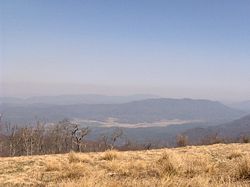
Cove (Appalachian Mountains)
In the central and southern Appalachian Mountains of Eastern North America, a cove is a small valley between two ridge lines that is closed at one or both ends....
known as a "limestone window
Window (geology)
thumb|right|350px|Schematic overview of a thrust system. The [[fault |hanging wall block]] is called a [[nappe]]. If an [[erosion]]al hole is created in the nappe that is called a window. A [[klippe]] is a solitary outcrop of the nappe in the middle of autochthonous material.A tectonic window...
," created by erosion that removed the older Precambrian
Precambrian
The Precambrian is the name which describes the large span of time in Earth's history before the current Phanerozoic Eon, and is a Supereon divided into several eons of the geologic time scale...
sandstone
Sandstone
Sandstone is a sedimentary rock composed mainly of sand-sized minerals or rock grains.Most sandstone is composed of quartz and/or feldspar because these are the most common minerals in the Earth's crust. Like sand, sandstone may be any colour, but the most common colours are tan, brown, yellow,...
, exposing the younger Paleozoic
Paleozoic
The Paleozoic era is the earliest of three geologic eras of the Phanerozoic eon, spanning from roughly...
limestone
Limestone
Limestone is a sedimentary rock composed largely of the minerals calcite and aragonite, which are different crystal forms of calcium carbonate . Many limestones are composed from skeletal fragments of marine organisms such as coral or foraminifera....
beneath. More weathering-resistant formations, such as the Cades sandstone which underlies Rich Mountain to the north and the Elkmont and Thunderhead sandstones which form the Smokies crest to the south surround the cove, leaving it relatively isolated within the Great Smokies. As with neighboring limestone windows such as Tuckaleechee to the north and Wear Cove
Wears Valley, Tennessee
Wears Valley is an unincorporated area in Sevier County, Tennessee, treated by the U.S. Census Bureau as a census county division. As of the 2000 Census, the population of Wears Valley was 6,486....
to the east, the weathering of the limestone produced deep, fertile soil, making Cades Cove attractive to early farmers.
The majority of the rocks that make up Cades Cove are unaltered sedimentary rocks formed between 340 million and 570 million years ago during the Ordovician
Ordovician
The Ordovician is a geologic period and system, the second of six of the Paleozoic Era, and covers the time between 488.3±1.7 to 443.7±1.5 million years ago . It follows the Cambrian Period and is followed by the Silurian Period...
period. The Precambrian rocks that comprise the high ridges surrounding the cove are Ocoee Supergroup sandstones, formed approximately 1 billion years ago. The mountains themselves were formed between 200 million and 400 million years ago during the Appalachian orogeny, when the North American and African plates collided, thrusting the rock formations upward.
Gregory's Cave
The fracturing and weathering of the limestone and sandstone in Cades Cove has led to the formation of several caveCave
A cave or cavern is a natural underground space large enough for a human to enter. The term applies to natural cavities some part of which is in total darkness. The word cave also includes smaller spaces like rock shelters, sea caves, and grottos.Speleology is the science of exploration and study...
s in the vicinity, the two largest of which are Gregorys Cave and Bull Cave. Bull Cave, at 924 feet (281 m), is the deepest cave in Tennessee. Trilobite
Trilobite
Trilobites are a well-known fossil group of extinct marine arthropods that form the class Trilobita. The first appearance of trilobites in the fossil record defines the base of the Atdabanian stage of the Early Cambrian period , and they flourished throughout the lower Paleozoic era before...
and brachiopod
Brachiopod
Brachiopods are a phylum of marine animals that have hard "valves" on the upper and lower surfaces, unlike the left and right arrangement in bivalve molluscs. Brachiopod valves are hinged at the rear end, while the front can be opened for feeding or closed for protection...
fossils have been found in Gregorys Cave.
The entrance to Gregory's Cave is approximately 10 feet (3 m) wide and 4 feet (1.2 m) high. The cave consists primarily of one large passage that averages 20 to 55 feet (16.8 m) wide and 15 feet (4.6 m) high. This passage is 435 feet (132.6 m) long and a side passage to the right (south) is developed about 300 feet (91.4 m) from the entrance. This side passage ends after about 100 feet (30.5 m). In the vicinity of this side passage are "Talley Marks" on the wall, which were typically left by saltpeter
Potassium nitrate
Potassium nitrate is a chemical compound with the formula KNO3. It is an ionic salt of potassium ions K+ and nitrate ions NO3−.It occurs as a mineral niter and is a natural solid source of nitrogen. Its common names include saltpetre , from medieval Latin sal petræ: "stone salt" or possibly "Salt...
miners. The dirt on this side of the cave has been excavated and removed and pick marks are still visible in the dirt. Saltpeter mining occurred in this region from the late 18th century through the Civil War, so this mining activity must have occurred sometime between 1818, when settlers arrived in Cades Cove and 1865, the end of the Civil War. Since this is a relatively small cave and the amount of dirt in the cave was not extensive, this would have been a small mining operation.
Gregory's Cave is the only cave in the national park that was ever developed as a commercial cave. The cave was opened to the public in July 1925. After the Gregory property was bought for the national park in 1935, the Gregory family was given a "lifetime dowry" and the owner, J. J. Gregory's wife Elvira, was allowed to live there until she died on March 26, 1943. One of her sons was allowed to remain on the property until he harvested his crop in the fall of 1943. After 1943, the property was completely owned by the National Park Service.
Donald K. MacKay, a geologist with the National Park Service, reported that the Gregory family still showing the cave commercially as late as 1935. At that time the admission price was 50 cents for adults and children were admitted free.
During its history as a commercial cave, Gregory's Cave had walkways, which were made of wood in some places, and electric lights. Wesley Herman Gregory, son of J. J. Gregory, reported that the lighting system was a "Delco System" This may have been a generator producing electricity for the lights inside the cave.
During the Cold War
Cold War
The Cold War was the continuing state from roughly 1946 to 1991 of political conflict, military tension, proxy wars, and economic competition between the Communist World—primarily the Soviet Union and its satellite states and allies—and the powers of the Western world, primarily the United States...
, Gregory's Cave was designated as a fallout shelter
Fallout shelter
A fallout shelter is an enclosed space specially designed to protect occupants from radioactive debris or fallout resulting from a nuclear explosion. Many such shelters were constructed as civil defense measures during the Cold War....
, with an assigned capacity of 1,000 people. The cave was stocked with food, water, and other emergency supplies.
Gregory's Cave is now securely gated and entrance is by permit only from the National Park Service. Entrance is generally restricted to scientific researchers.
Early history
Throughout the 18th century, the CherokeeCherokee
The Cherokee are a Native American people historically settled in the Southeastern United States . Linguistically, they are part of the Iroquoian language family...
used two main trails to cross the Smokies from North Carolina to Tennessee en route to the Overhill settlements
Overhill Cherokee
The term Overhill Cherokee refers to the former Cherokee settlements located in what is now Tennessee in the southeastern United States. The name was given by 18th century European traders and explorers who had to cross the Appalachian Mountains to reach these settlements when traveling from...
. One was the Indian Gap Trail, which connected the Rutherford Indian Trace in the Balsam Mountains to the Great Indian Warpath
Great Indian Warpath
The Great Indian Warpath — also known as the Great Indian War and Trading Path, or the Seneca Trail — was that part of the network of trails in eastern North America developed and used by Native Americans which ran through the Great Appalachian Valley...
in modern-day Sevier County
Sevier County, Tennessee
Sevier County is a county of the state of Tennessee, United States. Its population was 71,170 at the 2000 United States Census. It is included in the Sevierville, Tennessee, Micropolitan Statistical Area, which is included in the Knoxville-Sevierville-La Follette, TN Combined Statistical Area. The...
. The other was a lower trail that crested at Ekaneetlee Gap, a col just east of Gregory Bald. This trail traversed Cades Cove and Tuckaleechee Cove before proceeding along to Great Tellico
Great Tellico
Great Tellico was a Cherokee town at the site of present-day Tellico Plains, Tennessee, where the Tellico River emerges from the Appalachian Mountains. Great Tellico was one of the largest Cherokee towns in the region, and had a sister town nearby named Chatuga. Its name in Cherokee is more...
and other Overhill towns along the Little Tennessee River
Little Tennessee River
The Little Tennessee River is a tributary of the Tennessee River, approximately 135 miles long, in the Appalachian Mountains in the southeastern United States.-Geography:...
. European traders were using these trails as early as 1740.
By 1797 (and probably much earlier), the Cherokee had established a settlement in Cades Cove known as "Tsiya'hi," or "Otter Place." This village, which may have been little more than a seasonal hunting camp, was located somewhere along the flats of Cove Creek. Henry Timberlake, an early explorer in East Tennessee, reported that streams in this area were stocked with otter, although the otter was extinct in the cove by the time the first European settlers arrived.
Cades Cove was named after a Tsiya'hi leader known as Chief Kade. Little is known of Chief Kade, although his existence was verified by a European trader named Peter Snider (1776–1867), who settled nearby Tuckaleechee Cove. Abrams Creek, which flows through the cove, was named after another local chief, Abraham of Chilhowee. A now-discredited theory suggested that the cove was named after Abraham's wife, Kate.
The Treaty of Calhoun (1819) ended all Cherokee claims to the Smokies, and Tsiya'hi was abandoned shortly thereafter. The Cherokee would linger in the surrounding forests, however, occasionally attacking settlers until 1838 when they were removed to the Oklahoma Territory (see Trail of Tears
Trail of Tears
The Trail of Tears is a name given to the forced relocation and movement of Native American nations from southeastern parts of the United States following the Indian Removal Act of 1830...
).
European Settlement
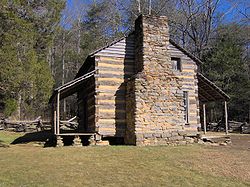
War of 1812
The War of 1812 was a military conflict fought between the forces of the United States of America and those of the British Empire. The Americans declared war in 1812 for several reasons, including trade restrictions because of Britain's ongoing war with France, impressment of American merchant...
, and his wife Lucretia Frazier (1795–1888) were the first permanent European settlers in Cades Cove. The Olivers, originally from Carter County
Carter County, Tennessee
Carter County is a county located in the U.S. state of Tennessee. As of 2010, the population was 57,424. Its county seat is Elizabethton.Carter County is part of the Johnson City Metropolitan Statistical Area, which is a component of the Johnson City–Kingsport–Bristol, TN-VA Combined...
, arrived in 1818, accompanied by Joshua Jobe, who had initially persuaded them to settle in the cove. While Jobe returned to Carter County,
the Olivers stayed, struggling through the winter and subsisting on dried pumpkin given to them by friendly Cherokees. Jobe returned in the Spring of 1819 with a herd of cattle in tow, and gave the Olivers two milk cows to ease their complaints.
In 1821, a veteran of the American Revolution
American Revolutionary War
The American Revolutionary War , the American War of Independence, or simply the Revolutionary War, began as a war between the Kingdom of Great Britain and thirteen British colonies in North America, and ended in a global war between several European great powers.The war was the result of the...
named William "Fighting Billy" Tipton (1761–1849) bought up large tracts of Cades Cove which he in turn sold to his sons and relatives, and settlement began to boom. In the 1820s, Peter Cable, a Pennsylvania Dutch farmer, arrived in the cove and designed an elaborate system of dykes and sluices that helped drain the swampy lands in the
western part of the cove. In 1827, Daniel Foute opened the Cades Cove Bloomery Forge to fashion metal tools. Robert Shields arrived in the cove in 1835, and would erect a tub mill on Forge Creek. His son, Frederick, built the cove's first grist mill. Other early settlers would build houses on the surrounding mountains, among them Russell Gregory (1795–1864), for whom Gregory Bald
Gregory Bald
Gregory Bald is a mountain on the western fringe of the Great Smoky Mountains. It has an elevation of 4,949 feet above sea level. The mountain's majestic summit makes it a popular hiking destination....
is named, and James Spence, for whom Spence Field
Spence Field
Spence Field is a highland meadow in the Great Smoky Mountains, located inthe Southeastern United States. It has an elevation of 4,920 feet above sea level...
is named.
Between 1820 and 1850, the population of Cades Cove grew to 671, with the size of cove farms averaging between 150 and 300 acres (0.6 and 1.2 km²). The early cove residents, although relatively self-sufficient, were dependent upon nearby Tuckaleechee Cove for dry goods and other necessities.
The isolation often attributed to Cades Cove is probably exaggerated. A post office was established in the cove in 1833, and Sevierville post master Philip Seaton set up a weekly mail route to the cove in 1839. Cades Cove had phone service as early as the 1890s, when Dan Lawson and several neighbors built a phone line all the way to Maryville. By the 1850s, various roads
connected Cades Cove with Tuckaleechee and Montvale Springs, some of which are still maintained as seasonal passes or hiking trails.
Religion In Cades Cove
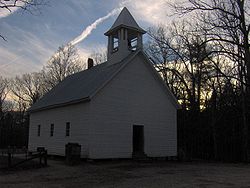
In the 1830s, a division in Baptist
Baptist
Baptists comprise a group of Christian denominations and churches that subscribe to a doctrine that baptism should be performed only for professing believers , and that it must be done by immersion...
churches known as the Anti-mission Split occurred throughout East Tennessee. The split was due to a debate over whether or not missions
Mission (Christian)
Christian missionary activities often involve sending individuals and groups , to foreign countries and to places in their own homeland. This has frequently involved not only evangelization , but also humanitarian work, especially among the poor and disadvantaged...
and other "innovations of the day"
were authorized by scripture. This debate made its way to Cades Cove Baptist Church in 1839, becoming so emotionally charged as to require the intervention of the Tennessee Association of United Baptist. In the end, 13 members of the congregation
departed to form the Cades Cove Missionary Baptist Church later that year, and the remaining congregation changed its name to the Primitive Baptist Church in 1841. The Primitive Baptist
Primitive Baptist
Primitive Baptists, also known as Hard Shell Baptists or Anti-Mission Baptists, are conservative, Calvinist Baptists adhering to beliefs that formed out of the controversy among Baptists in the early 1800’s over the appropriateness of mission boards, bible tract societies, and temperance...
s, as the name implies, believed in a strict, literal interpretation of Biblical scripture. William Howell Oliver (1857–1940), pastor of the Primitive Baptist Church from 1882 to
1940, explained:
We believe that Jesus Christ himself instituted the Church, that it was perfect at the start, suitably adopted in its organization to every age of the world, to every locality of earth, to every state and condition of the world, to every state and condition of mankind, without any changes or alterations to suit the times, customs, situations, or localities.
The Primitive Baptists remained the dominant religious and political force in the cove, their meetings interrupted only by the Civil War. The Missionary Baptists
Missionary Baptists
Missionary Baptists are a group of Baptists that grew out of the missionary / anti-missionary controversy that divided Baptists in the United States in the early part of the 19th century, with Missionary Baptists following the pro-missions movement position...
, with a much smaller congregation, continued to meet on and off throughout the 19th century.
The Cades Cove Methodist Church was organized in the 1820s, probably due to the efforts of circuit riders
Circuit rider (Religious)
Circuit rider is a popular term referring to clergy in the earliest years of the United States who were assigned to travel around specific geographic territories to minister to settlers and organize congregations...
such as George Eakin. The Methodist congregation, like that of the Missionary Baptist, was relatively small.
The Civil War
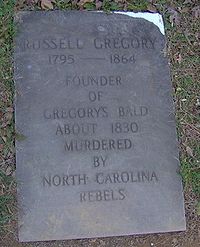
Blount County, Tennessee
Blount County is a U.S. county located in the U.S. state of Tennessee. Its population was 123,010 at the United States Census, 2010. The county seat is at Maryville, which is also the county's largest city....
was a hotbed of abolitionist activity. The Manumission Society of Tennessee was active in the county as early as 1815, and the Quakers— who were relatively-numerous in Blount at the time— were so vehemently opposed to slavery that they fought alongside the Union army, in spite of their pacifist agenda. The founder of Maryville College
Maryville College
Maryville College is a private four-year liberal arts college in Maryville, Tennessee, near Knoxville. It was founded in 1819 by Presbyterian minister Isaac L. Anderson for the purpose of furthering education and enlightenment into the West. The College is one of the fifty oldest colleges in the...
, Rev. Isaac Anderson, was a staunch abolitionist who often gave sermons in Cades Cove. Blount doctor Calvin Post (1803–1873) was believed to have set up an Underground Railroad
Underground Railroad
The Underground Railroad was an informal network of secret routes and safe houses used by 19th-century black slaves in the United States to escape to free states and Canada with the aid of abolitionists and allies who were sympathetic to their cause. The term is also applied to the abolitionists,...
stop within the cove in the years preceding the war. With such sentiment and influence, it's no surprise
that Cades Cove remained staunchly pro-Union, regardless of the destruction it suffered throughout the war (there were some exceptions, however, such as the cove's affluent entrepreneur and Confederate sympathizer, Daniel Foute).
In 1863, Confederate bushwhackers from Hazel Creek
Hazel Creek (Great Smoky Mountains)
Hazel Creek is a tributary stream of the Little Tennessee River in the southwestern Great Smoky Mountains of North Carolina. The creek's bottomlands were home to several pioneer Appalachian communities and logging towns before its incorporation into the Great Smoky Mountains National Park...
and other parts of North Carolina began making systematic raids into Cades Cove, stealing livestock and killing any Union supporter they could find. Elijah Oliver (1829–1905), a son of John Oliver and a Union sympathizer, was forced to hide out on Rich Mountain for much of the war. Calvin Post had also gone into hiding, and with the death of John Oliver in 1863, the cove had lost most of its original leaders.
Although Federal forces occupied Knoxville in 1863, Confederate raids into Cades Cove continued. A pivotal figure at this time was Russell Gregory, who had originally vowed to remain neutral after his son's defection to the Confederate cause. Gregory organized a small militia, composed mostly of the cove's elderly men, and in 1864 ambushed a band of Confederate marauders near the junction of Forge Creek and Abrams Creek. The Confederates were routed and chased back across the Smokies to North Carolina. Although this largely put an end to the raids, a band of Confederates managed to sneak into the cove and kill Gregory just two weeks later.
Cades Cove would suffer from the effects of the Civil War for most of the rest of the 19th century. Only around 1900 did its population return to pre-war levels. The average farm was much less productive, however, and the cove residents were suspicious of any form of change. It wasn't until the Progressive Era
Progressive Era
The Progressive Era in the United States was a period of social activism and political reform that flourished from the 1890s to the 1920s. One main goal of the Progressive movement was purification of government, as Progressives tried to eliminate corruption by exposing and undercutting political...
that the cove recovered, economically.
Moonshining and Prohibition

Moonshine
Moonshine is an illegally produced distilled beverage...
distillers was Josiah "Joe Banty" Gregory (1870–1933), the son of Matilda "Aunt Tildy" Shields by her first marriage. The Primitive Baptists, especially William Oliver and his son, John W. Oliver (1878–1966), were fervently opposed to the distilling or consumption of alcohol
Alcoholic beverage
An alcoholic beverage is a drink containing ethanol, commonly known as alcohol. Alcoholic beverages are divided into three general classes: beers, wines, and spirits. They are legally consumed in most countries, and over 100 countries have laws regulating their production, sale, and consumption...
, and the practice was largely confined to Chestnut Flats. John W. Oliver, who was a mail carrier in the cove, often found stills on his mail route and reported them to authorities. Oliver would later deride the image of the moonshiner as an integral part of the mountaineer stereotype:
All these men are public outlaws, and were never recognized as true, loyal mountaineers or as true American citizens, by the rank and file of the mountain people.
In 1921, Josiah Gregory's still was raided by the Blount County sheriff. Although it was later revealed that the sheriff was tipped off by a surveyor in the area, the Gregorys blamed the Olivers. On the night following the raid, the barns of both William and John W. Oliver were burned, destroying a large portion of the family's livestock and tools. Shortly thereafter, Gregory's son was assaulted by Asa and John Sparks after a prank-gone-wrong. In response, Gregory and his brother, Dana, hunted down and
shot the Sparks brothers on Christmas night in 1921. Both of the Gregorys were convicted of barn burning and later convicted of felonious assault. After serving only six months, however, they were pardoned and personally escorted home by Governor Austin Peay
Austin Peay
Austin Peay was Governor of Tennessee from 1923 until his death in 1927.-Biography:Peay, a native of Kentucky, moved to Clarksville, Tennessee and opened a law practice in 1896. He was first elected to the Tennessee House of Representatives in 1901 and re-elected in 1903...
.
As mentioned previously, Gregory's cave may also have been involved in the manufacture of moonshine.
The National Park
Of all the Smoky Mountain communities, Cades Cove put up the most resistance to the formation of the Great Smoky Mountains National Park. The cove residents were initially assured their land would not be incorporated into the park, and welcomed its formation. By 1927, the winds had changed, however, and when the Tennessee General Assembly passed a bill approving money to buy land for the national park, it gave the Park Commission the power to seize properties within the proposed park boundaries by eminent domainEminent domain
Eminent domain , compulsory purchase , resumption/compulsory acquisition , or expropriation is an action of the state to seize a citizen's private property, expropriate property, or seize a citizen's rights in property with due monetary compensation, but without the owner's consent...
. Long-time residents of Cades Cove were outraged. The head of the Park Commission, Colonel David Chapman, received several threats, including an anonymous phone call warning him that if he ever returned to Cades Cove, he would "spend the next night in hell." Shortly thereafter, Chapman found a sign near the cove's entrance that read {sic}:
COL. CHAPMAN: YOU AND HOAST ARE NOTFY, LET THE COVE PEOPL ALONE. GET OUT. GET
GONE. 40 M. LIMIT.
The "40 mile" (64 km) limit referred to the distance between Cades Cove and Chapman's hometown of Knoxville. Despite these threats, Chapman initiated a condemnation suit against John W. Oliver in July 1929. The court, however, ruled in favor of Oliver,
reasoning that the federal government had never said Cades Cove was essential to the national park. Shortly after the verdict, the Secretary of the Interior officially announced that the cove was necessary, and another condemnation suit was filed. This time, Oliver lost, with the case going all the way to the Tennessee Supreme Court. Oliver would return to court several times over the
value of his 375 acre (1.5 km²) tract, which he said was worth $30,000, although the court awarded him just $17,000 plus interest. After attaining a series of one-year leases, Oliver finally abandoned his property on Christmas Day in 1937. The Primitive Baptist Church congregation continued to meet in Cades Cove until the 1960s in defiance of the park service, who wanted to develop the land where their church was located.
For about one-hundred years before the creation of the national park, much farming and logging
Logging
Logging is the cutting, skidding, on-site processing, and loading of trees or logs onto trucks.In forestry, the term logging is sometimes used in a narrow sense concerning the logistics of moving wood from the stump to somewhere outside the forest, usually a sawmill or a lumber yard...
was done in the valley, as the main source of economic development for the peoples living in the cove, both leading to massive deforestation
Deforestation
Deforestation is the removal of a forest or stand of trees where the land is thereafter converted to a nonforest use. Examples of deforestation include conversion of forestland to farms, ranches, or urban use....
. At first, the National Park Service
National Park Service
The National Park Service is the U.S. federal agency that manages all national parks, many national monuments, and other conservation and historical properties with various title designations...
planned to let the cove return to its natural forested state. It ultimately yielded to requests by the Great Smoky Mountain Conservation Association to maintain Cades Cove as a meadow. Nonetheless, on the advice of contemporary cultural experts such as Hans Huth, the service demolished the more modern structures, leaving only the primitive cabins and barns which were considered most representative of pioneer life in early Appalachia. In its day, the cove was as well educated and progressive as any rural community in Blount County.
Historical structures in Cades Cove
Cades Cove has been listed on the National Register of Historic PlacesNational Register of Historic Places
The National Register of Historic Places is the United States government's official list of districts, sites, buildings, structures, and objects deemed worthy of preservation...
as an historic district
Historic district (United States)
In the United States, a historic district is a group of buildings, properties, or sites that have been designated by one of several entities on different levels as historically or architecturally significant. Buildings, structures, objects and sites within a historic district are normally divided...
since July 13, 1977. The historic district is bounded by the 2000 feet (609.6 m) elevation contour (that is, it comprises all areas below that elevation) and includes both historic buildings and prehistoric archaeological sites.
The National Park Service currently maintains several buildings in Cades Cove that are representative of pioneer life in the 19th century Appalachia. By the time the cove was incorporated into the park, most residents lived in relatively modern frame houses, rather than the log cabins that predominate among the buildings preserved in the cove.
The following are listed in the order they are approached along the Cades Cove Loop Road:
1. The John Oliver Cabin, constructed c. 1822-1823 by the cove's first permanent European settlers. Dunn reports that the Olivers spent the winter of 1818-1819 in an abandoned Cherokee hut, and built a crude structure the following year. The Oliver Cabin was built as a replacement for this first crude structure, which was located a few meters behind the cabin.
2. The Primitive Baptist Church, constructed in 1887. The church was organized as the Cades Cove Baptist Church in 1827, and renamed "Primitive Baptist" after the Anti-missions Split in 1841. The Olivers and Russell Gregory are buried in its cemetery.
3. The Cades Cove Methodist Church, constructed in 1902. Methodists were active in the cove as early as the 1820s, and built their first meeting house in 1840.
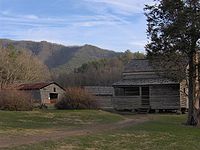
5. The Myers Barn, constructed in 1920. The Myers Barn is a more modern-looking hay barn located along the trail to the Elijah Oliver Place.
6. The Elijah Oliver Place, constructed in 1866. Elijah Oliver (1829–1905) was the son of John and Lucretia Oliver. His original farm was destroyed during the U.S. Civil War by Confederate marauders. The homestead includes a dog-trot cabin
Dogtrot house
The dogtrot, also known as a breezeway house, dog-run, or possum-trot, is a style of house that was common throughout the Southeastern United States during the 19th and early 20th centuries. Most theories place its origins in the southern Appalachian Mountains. Some scholars believe the style...
, a chicken coop, a corn crib, and a crude stable.
7. The John Cable Grist Mill, constructed in 1868. John P. Cable (1819–1891), a nephew of Peter Cable, had to construct a series of elaborate diversions along Mill Creek and Forge Creek to get enough water power for the mill's characteristic overshot wheel.
8. The Becky Cable House, constructed in 1879. This building, adjacent to the Cable Mill, was initially used by Leason Gregg as a general store. In 1887, he sold it to John Cable's spinster daughter, Rebecca Cable (1844–1940). A Cable family tradition says that Rebecca never forgave her father and refused to marry after her father broke off one of her childhood romances. Various buildings have been moved from elsewhere in the cove and placed near the Cable mill, including a barn, a carriage house, a chicken coop, a molasses still, a sorghum press, and a replica of a blacksmith shop.
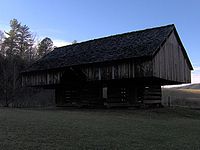
10. The Dan Lawson Place, built by Peter Cable in the 1840s and acquired by Dan Lawson (1827–1905) after he married Cable's daughter, Mary Jane. Lawson was the cove's wealthiest resident. The homestead includes a cabin (still called the Peter Cable cabin), a smokehouse, a chicken coop, and a hay barn.
11. The Tipton Place, built in the 1880s by the descendants of Revolutionary War veteran William "Fighting Billy" Tipton. The paneling on the house was a later addition. Along with the cabin, the homestead includes a carriage house, a smokehouse, a woodshed, and the oft-photographed double-cantilever barn.
12. The Carter Shields Cabin, a rustic log cabin built in the 1880s.
Touring
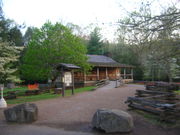
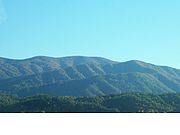
American black bear
The American black bear is a medium-sized bear native to North America. It is the continent's smallest and most common bear species. Black bears are omnivores, with their diets varying greatly depending on season and location. They typically live in largely forested areas, but do leave forests in...
sightings, although many enthusiasts make the trip for the abundant hiking access and well-preserved 19th century homesteads. On most days, multiple deer
Deer
Deer are the ruminant mammals forming the family Cervidae. Species in the Cervidae family include white-tailed deer, elk, moose, red deer, reindeer, fallow deer, roe deer and chital. Male deer of all species and female reindeer grow and shed new antlers each year...
can be seen in the meadows and woods throughout the cove. Popular hiking trails within the cove include the trails to Abrams Falls
Abrams Falls Trail
The Abrams Falls Trail is an American hiking trail, in the Great Smoky Mountains National Park of Blount County, Tennessee. The trail runs parallel to Abrams Creek and passes Abrams Falls, one of the most voluminous waterfalls in the national park, before terminating at a junction with the Hatcher...
and Gregory Bald
Gregory Bald
Gregory Bald is a mountain on the western fringe of the Great Smoky Mountains. It has an elevation of 4,949 feet above sea level. The mountain's majestic summit makes it a popular hiking destination....
, the latter named after Russell Gregory, a prominent resident of the cove. In addition to hiking and general sightseeing, horseback and bicycle riding are popular activities.
External links
- Cades Cove, Great Smoky Mountains National Park website
- Cades Cove photos, National Register of Historic Places
- Cades Cove Preservation Association

